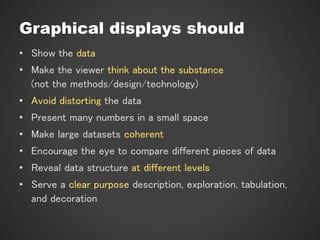Principles of Infographic Design
- 1. Principles of Infographic Design Tips on how we graphic like a designer Leo
- 2. Infogr.am: All The Bells And Whistles Ī░ Č╠įuŻ║╣Ā▒Š╔┘Ż¼«ŗ╠ž╩ŌłD║├ė├ Ī▒
- 3. InfoActive: Interactive, Live And Mobile-Friendly Ī░ Č╠įuŻ║ĄĮ¼Fį┌▀Ćø]═©▀^į]āį =┐┌= Ī▒
- 4. Piktochart: Drag-And-Drop Templates Galore Ī░ Č╠įuŻ║IconČÓŻ¼┐╔┤µłD Ī▒
- 10. Distribution
- 12. Time Series
- 13. Edward Tufte Born 1942 Statistician Graphic Designer Author
- 14. Graphical displays should ? Show the data ? Make the viewer think about the substance (not the methods/design/technology) ? Avoid distorting the data ? Present many numbers in a small space ? Make large datasets coherent ? Encourage the eye to compare different pieces of data ? Reveal data structure at different levels ? Serve a clear purpose description, exploration, tabulation, and decoration
- 15. Traffic deaths
- 16. Traffic deaths
- 18. Data-Ink Ratio Data-Ink ratio = data-ink total ink used to print graphic = proportion of graphicĪ»s ink devoted to the non-redundant display of data-information = 1 ©C proportion of graphic that can be erased without loss of data information
- 19. Chart Junk 3D = no extra information Latest results from only 6 months
- 21. Chart Junk
- 23. Substance?......... NO! ONLY 5 NUMBERS!! ColoursĪŁĪŁĪŁĪŁĪŁ YES 3D effectsĪŁĪŁĪŁ.. YES Disguised redundancy...YES Mirror imaging Curved lines Tufte (1983, p.118) says, "This may well be the worst graphic ever to find its way into print."
- 30. ČÓ▒õŽŅĮ╗▓µ
- 31. ČÓ▒õŽŅĮ╗▓µ
- 40. Principles ? Apprehension ? Clarity ? Consistency ? Efficiency ? Necessity ? Truthfulness
- 45. Excel Demo
- 46. Infographic į¬╦ž ╬─ūų Ņü╔½ ¤o▓╩╔½║├ė├ę²ī¦ķåūx ╦ž▓─ łD▒Ē ├└ė^ĪółD╩ŠĪóį]ĮŌ ūŅ┤¾┘YėŹ─½╦«▒╚
- 54. Colors make differences ExcelŅAįO╔½▓╩ ? ═¼ę╗Ę▌łD▒Ēā╚ę╗ų┬’LĖ± ║åå╬Ż║╔½ŽĄąĪņČ3ĘN (¤o▓╩╔½▓╗ī┘ņČ╚╬║╬╔½ŽĄ) ╔Ņ£\Īó’¢║═Č╚▓Ņ«É 0 1 2 3 4 5 6 ŅÉäe 1 ŅÉäe 2 ŅÉäe 3 ŅÉäe 4 ╠O╣¹ ķ┘ūė ŽŃĮČ ╠½Ļ¢╗© 0 1 2 3 4 5 6 ŅÉäe 1 ŅÉäe 2 ŅÉäe 3 ŅÉäe 4 ╠O╣¹ ķ┘ūė ŽŃĮČ ╠½Ļ¢╗©
- 55. ╦ž▓─
- 56. ╦ž▓─
- 57. Excel Demo



![InfoActive: Interactive, Live And Mobile-Friendly
Ī░ Č╠įuŻ║ĄĮ¼Fį┌▀Ćø]═©▀^į]āį =┐┌= Ī▒](https://image.slidesharecdn.com/infographicnew-160112125844/85/Principles-of-Infographic-Design-3-320.jpg)










































![Infographic į¬╦ž
╬─ūų Ņü╔½
¤o▓╩╔½║├ė├ę²ī¦ķåūx
╦ž▓─ łD▒Ē
├└ė^ĪółD╩ŠĪóį]ĮŌ ūŅ┤¾┘YėŹ─½╦«▒╚](https://image.slidesharecdn.com/infographicnew-160112125844/85/Principles-of-Infographic-Design-46-320.jpg)











